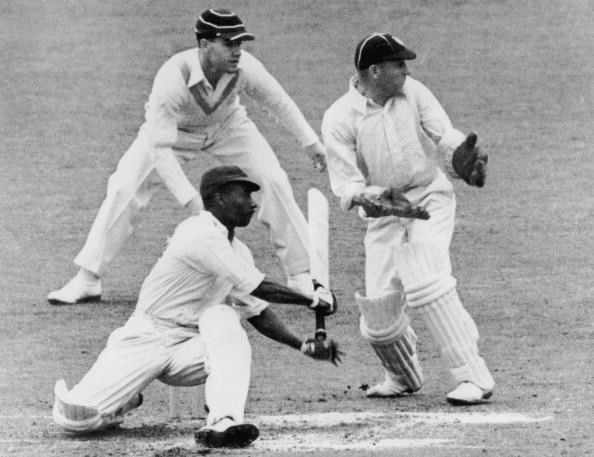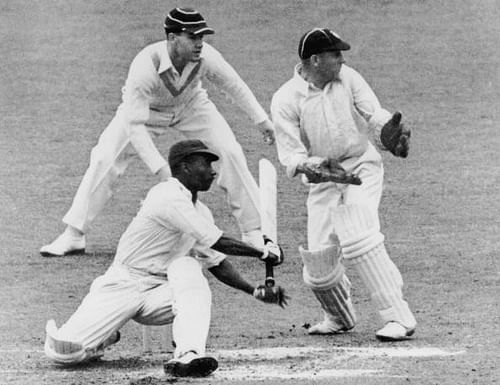
4 players who were supposedly better than Sir Donald Bradman
Let me begin this article apologizing to all cricket devotees who would consider questioning Bradman’s forte a blasphemy. But I indulge myself in questioning percepts and I am a proud adherent of “Socratic questioning”.Though, the belief world over is that Bradman is the greatest ever cricketer of all time, there have been nonconformists who have questioned such an Apocrypha.This article is not intended to draw comparisons between Bradman and those who were considered to be better. Instead, this is just a compilation of all those who were considered to be better than Bradman at one time or another.
#1 George Headley

Perhaps, the first in the pedigree of swashbuckling stroke makers from West Indies, George Headley was known as the Black Bradman. But the West Indians were content in calling Don Bradman, the white George Headley.
Born in the non-cricketing country of Panama, Headley’s father was involved in the building of the Panama Canal. Legend has it that when the eight year old Headley was gawking at a game of rounders in a nondescript village, a ball flew by his way which he plucked out of the air with his body flung up. The crowd went into raptures as the team approached the kid to play in the big match due the following Sunday. On Sunday evening he would be carried to his home on the shoulders of the other players as the eight year old took a match winning blinder at a crunch stage of the game.
Coming from a Spanish speaking family, Headley’s parents wanted him to be a dentist in the USA. Hence, he was sent to Jamaica to learn English, throwing him into the arms of cricket.
His inherent batting skills became apparent as he snowballed into a prodigy batsman, capable of outclassing the senior pros. Barely 19, the lean right hander was picked for the Jamaican side to play against Hon. LH Tennyson’s XI. Braving the pace of Nobby Clark and co. the Black Bradman scored 16, 71, 211, 40, and 71.
George’s parents had already migrated to the States by then and had it not been for the delayed post that was bearing his travel documents, Headley would not have played that match and cricket would have lost its gem.
Colour discrimination, racism and politics made sure the talented teenager could not find himself a place in the West Indies side that toured England in 1928. However, he was too talented to be kept out of the side for too long. He was in the team when England toured the West Indies 1929 and amassed 703 runs in eight test innings with an average of 87.80. He scored 176 in the first test, 114 and 112 in the third and 223 in the fourth. His 223 in the fourth innings of the fourth test is still the highest score made by any batsman in the fourth innings of a game.
In the tour of Australia in 1930/31 he plundered a thousand runs with two centuries. The only other batsman to score in excess of 1000 in that season was Bradman himself. With the cadaverous marauder socking bowlers around, soon news spread that Headley was invincible on the off side. Clarrie Grimmett, an Australian leg-break bowler countered it by bowling leg side to the West Indian batsman. George Headley initially struggled. But he went back to the nets practiced his leg side shots, came back and took Grimmett on in the leg side. Grimmett, who had bowled to most prolific batsmen of his time including Bradman, proclaimed he was the best he had ever bowled to, and irony be, Grimmett was a tormentor for Bradman.
In 1932, against a touring English first class team he hit 344 not out which according to the observers was the perfect innings. Against Tennyson’s England, Headley amassed 723 runs being dismissed only twice. His lowest score was 84 and his average was a Himalayan 361.5. Those were innings of perfection replete with variety of strokes. In that year, he never looked like getting out.
Don Bradman described him as a batsman “predominantly strong on leg side”. “I rate him very highly”, was his words on Headley.
Jack Egan, a cricket historian, opines that George Headley was similar in demeanor to Bradman at the crease, and was more stylish, graceful and attractive than Bradman. George was the only proper batsman in the West Indian team. The fact that out of the 22 centuries scored for West Indies until 1939, 10 of them were scored by Headley, shows that how much the team was dependent on him. For this very reason, Headley was called The Atlas, for single handedly carrying West Indies on his shoulders.
In 1935, when England toured West Indies, Headley flourished on wet wickets. Observers state that Headley was the best ever wet wicket batsman, a feat that is accentuated by the fact that Bradman wasn’t a prolific scorer on wet wickets. In the last Test of that 1935 series, the Black Bradman notched 270 not out to help West Indies win its first series against England.
He is known to be a sharp-thinking, astute, graceful and intelligent cricketer. He is told to have had a sparkle in his eyes which was the hallmark of many great batsmen. Eminent journalists describes him as a working man’s hero. He was the first cricket superstar of the black lower class of Jamaica.
For the Jamaican youths who were desperate to make a mark for themselves in the society, Headley was a beacon. He was an icon and inspiration for his people. Michael Holding states that, being a black Jamaican to have travelled world over and achieved so much when blacks were being treated as second class citizens, Headley was a game changer to the doomed black youths. The amount of knowledge he possessed about cricket should have made him a captain in 1939. But the color of his skin denied him of such a privilege.
By that time, the world was at war and Headley was at his peak. Sadly, the world war halted cricket. When peace resumed, Headley had passed him prime. In 1948, he was made West Indies captain, an honour for the blacks as a whole. While aged 45, the West Indians wanted Headley to be back in the Test team in 1954, so that the youths could motivate themselves watching the game’s greatest.
A modest, shrewd cricketer, laid the foundation for the thriving of Caribbean cricket. He was a hope for the blacks. He made them believe, despite the myths surrounding the blacks that they are inept, that they can conquer the world – which culminated in the Invincibles of the 1970’s and 80’s. With a better team and matches during the peak of his career he could have achieved much more than what Bradman did.
George Headley averages 60.83 in 22 matches with 10 centuries. Though the numbers don’t do justice to his ability, the observers of his time rate him as highly as Bradman, if not higher.